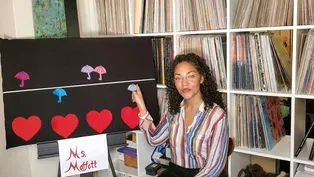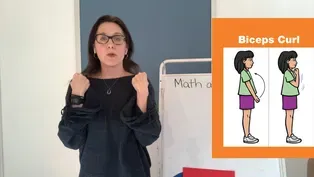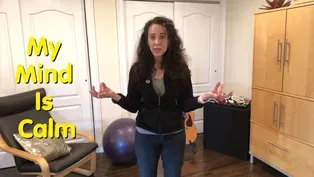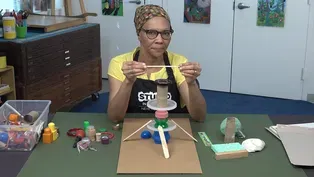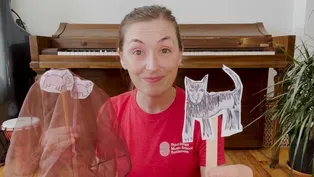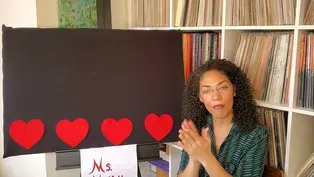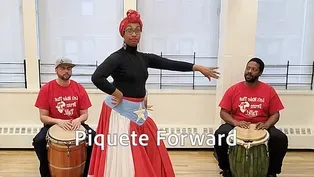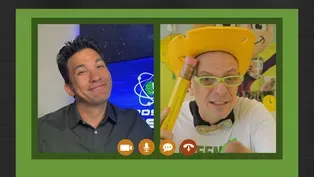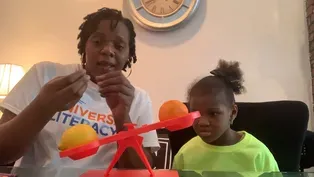
What Sounds Do You Hear in Crunch?
3/15/2021 | 56m 4sVideo has Closed Captions
Learn about different kinds of communities, set a table for a party, read ALFIE.
Learn about different kinds of communities, set a table for a party, read ALFIE, review initial blends with r. LET’S LEARN helps children ages 3-8 with at-home learning. One-hour programs feature instruction by educators and virtual field trips.
Problems with Closed Captions? Closed Captioning Feedback
Problems with Closed Captions? Closed Captioning Feedback
Let's Learn is a local public television program presented by THIRTEEN PBS

What Sounds Do You Hear in Crunch?
3/15/2021 | 56m 4sVideo has Closed Captions
Learn about different kinds of communities, set a table for a party, read ALFIE, review initial blends with r. LET’S LEARN helps children ages 3-8 with at-home learning. One-hour programs feature instruction by educators and virtual field trips.
Problems with Closed Captions? Closed Captioning Feedback
How to Watch Let's Learn
Let's Learn is available to stream on pbs.org and the free PBS App, available on iPhone, Apple TV, Android TV, Android smartphones, Amazon Fire TV, Amazon Fire Tablet, Roku, Samsung Smart TV, and Vizio.
Providing Support for PBS.org
Learn Moreabout PBS online sponsorshipMore from This Collection
Video has Closed Captions
Read SCHOOL BUS and draw one, learn about prefixes and pitch, build sculptures. (57m 48s)
Running and Counting Both End in “ing”!
Video has Closed Captions
Move to improve, find the missing number, learn songs from Ghana, read ABUELITA’S SECRET. (58m 17s)
What Sound Does “aw” Make in Draw?
Video has Closed Captions
Read a story, discover "au" and "aw," learn about density, count, and move with music. (56m 58s)
Can You Find the Short “u” in Subtract?
Video has Closed Captions
Help Super Grover 2.0 solve a prickly problem, read ALL THE WAYS TO BE SMART. (56m 19s)
What Sound Does “gl” Make in Glove?
Video has Closed Captions
Play the glockenspiel, help Super Grover 2.0 make a cart move, read TWO WOOL GLOVES. (58m 9s)
Incredible Starts with Short “i”!
Video has Closed Captions
Solve problems with Super Grover 2.0, catch a rainbow, hear a piano sound like a cuckoo. (56m 9s)
What’s the Sound of “oo” in Book?
Video has Closed Captions
Explore animals’ form and function, sing about the 3 little pigs, read THE LITTLE BOX. (58m 15s)
We’re Reducing, Reusing and Recycling!
Video has Closed Captions
Learn all about rhythm and the number 9, read A BAG IN THE WIND. (56m 17s)
Video has Closed Captions
Learn to dance bomba and grow food in a city, read WOLF CUB’S SONG. (55m 20s)
How Many Syllables are in Invent?
Video has Closed Captions
Invent your own instrument, make 10 to add numbers to 20, read ONE GOLDEN RULE AT SCHOOL. (57m 36s)
Video has Closed Captions
Learn about the science behind mind reading, count shells, read MY BIG FAMILY. (57m 27s)
Which is Heavier: One Apple or Two Apples?
Video has Closed Captions
Defy gravity, learn secret code words for fast and slow in music, read WHOOO KNEW? (58m 5s)
Providing Support for PBS.org
Learn Moreabout PBS online sponsorship[upbeat music] - [Announcer] Ready to learn?
- Hi!
- Hi!
- [Announcer] It's time to share a story, read, and write.
- Let's read it back.
- [Announcer] Discover science, sing.
♪ Somewhere ♪ - [Announcer] Play, and so much more.
- Cupcake!
- Very good.
- [Announcer] Stay tuned for lessons and activities.
- We're gonna start making some words.
Isn't that fun?
- [Announcer] Funding for this program was provided by the JPB Foundation.
- Hi, everyone.
My name is Emmy and I'm a teaching artist with New York City Children's Theater.
Today, we're going to be reading one of my favorite books, "Alfie," by Thyra Heder, who also drew the pictures that you'll see in the book.
This book is about a girl named Nia and her turtle, Alfie, who wants to show Nia just how much he appreciates or wants to show thanks to her.
After we read our book today, we're going to think about how we can show appreciation or thanks to the people in our own lives.
Okay, let's get started.
"Alfie" by Thyra Heder.
"On my sixth birthday, I got Alfie.
The lady at the store said he looked about six too.
We were six together.
At home, on my carpet, he stood very still.
I introduced him to everyone.
I taught him my wiggle dance."
Look at Nia's wiggle dance.
Should we all wiggle together?
Okay, let's all wiggle together on the count of three.
Ready?
One, two, three.
Wiggle, wiggle, wiggle, wiggle, wiggle.
All right, good job.
"And made him presents, but he didn't seem to notice.
I showed him my costumes and wrote him songs.
Mostly, he stayed inside his shell."
I wonder why.
"Every day I told him stories like how Dasha got new overalls and how Ruth lost a tooth."
Have you ever lost a tooth before?
I have.
"And how Peter from downstairs got a fish.
I even told him my best joke about the walrus wearing pants, but he didn't seem to get it.
After a while, I kind of forgot about Alfie.
He didn't do much.
Well, until the morning of my seventh birthday when he disappeared."
Where do you think Alfie went?
Let's find out.
Oh, and this looks like a drawing of Mia and a drawing of Alfie.
"When I first saw Nia, I knew she was special."
So who's talking now?
Alfie the turtle's talking.
"She told me that I was six and she was six too.
I had never been six before, but I was happy we were six together.
Her home tickled my toes, but she smelled nice, so I was calm.
She had tons of friends.
Nia taught me to dance.
I practiced wiggling inside my shell."
Just like we just practiced wiggling and Alfie likes to wiggle inside his shell, so that's why he stayed in.
"She gave me presents.
I had never been given presents.
She made me laugh, and laugh, and laugh."
Now let's look at Alfie's face in this picture.
Does Alfie look like he's laughing?
He looks pretty serious to me.
Alfie's face is like this.
But when people laugh, what do their faces look like?
Yes, they smile, and they give a big laugh, like ha, ha, ha, ha, ha.
So it seems like turtles laugh differently than people do, and maybe that's why Nia thought that he wasn't laughing because she couldn't tell.
"How could I make her as happy as she made me?"
So Alfie wants to show his appreciation and thanks to Nia.
"I had to think, and think, and think.
Nia was planning her seventh birthday.
She told me we were going to be seven together.
I had to find her a present."
So that's where Alfie disappeared to.
"There were some good options behind the couch but they were too dusty.
I looked in all the corners, and shadows, and cracks, and found some great places."
It looks like Alfie found a hiding place in a slipper but no great presents.
"I asked Toby, this very happy dog, and he said, 'You should try outside.
Outside is the best, outside is the best.
Get her a stick.'"
It seems like Toby really likes to play with sticks.
"I had never been outside before.
I climbed past stinky things and sweet things, but nothing as fun as Nia.
I had to keep looking.
I had to take a risk.
I crunched."
Oh, should we all crunch together, on the count of three do a crunch sound?
Ready?
One, two, three, crunch.
Oh, good job.
"Through the reds and oranges and yellows, but the longer I looked for a special one, the browner they got."
Do you ever like to look at the leaves on the trees in the fall?
And do you see how they're red, and orange, and yellow, and bright?
And when they fall to the ground, they turn browner.
Turtles move really slowly, so if the leaves are turning browner while Alfie is walking through them, he's taking a really long time to walk.
"I found a nice blue cap, but it was too small for Nia's head."
It looks like it fits Alfie's head though.
"There was nothing in the desert."
I think that the desert is a sandbox.
"My toes were cold and my heart was sad.
I would never find a present as special as my friend.
The snail said all I needed was a good rest.
He knew the perfect place for me to take a nap.
'Just over those stones,' he said."
Snails also move very slowly, so I think that they would talk slowly too.
"So I napped, and napped, and napped."
What's on the ground in this picture?
Snow.
And what's on the ground in this picture here, and behind Nia, and what's she planting?
Flowers.
So it looks like Alfie napped through the winter and the spring.
That's a really long time.
"When I woke up, I felt better.
I asked the fish for help and she showed me the things that had fallen to the bottom.
Then I saw it.
It was perfect.
It looked just like something Nia would love."
And take a look, what is this?
It's a toy turtle, not a real turtle, but a toy.
So I think that Alfie knows that Nia really loves him because he thinks that the perfect gift for her to show his appreciation would be something that looks just like him.
"I had to rush to the party.
When I finally got over the rocks, the snail said, 'That was fast.'"
Maybe for a snail it was fast, but for people it would probably be pretty slow.
"I was right on time.
There she was.
I could tell Nia was very surprised and happy.
I had brought her the perfect present.
Now we were seven together."
Look at the number on the balloon.
What number is this?
Eight, not seven.
So, Alfie and Nia, were supposed to turn seven together but that was last year.
So Alfie took a whole year to get Nia that very special present, but it seems like he did a good job because they both seem very, very happy.
And this is a picture of Alfie and Nia playing together.
Wow, I hope that you enjoyed that book as much as I did.
I'm so happy that Alfie was able to find his way back to Nia and give her a gift that really showed his appreciation for her.
In the beginning of the book, it seemed like Alfie didn't really notice all of the nice things that Nia was doing for him like introducing him to her friends and showing him how to wiggle, but later we found out that Alfie did appreciate those things, he just had a different way of showing it, like he liked to wiggle inside his shell, and he laughed differently than a person might laugh, than what Nia is used to.
People and pets have very different ways of showing their appreciation or thank you.
I want us to think about someone in our lives that we would like to show thank you or appreciation for.
It could be a grownup, it could be someone that you live with, or a friend, or a pet.
Maybe you have a pet turtle, like in our book.
I think I would like to show appreciation for my brother.
Take a second and think about who you would wanna show appreciation for.
Do you have it?
Let's say it together on the count of three.
Ready?
One, two, three, my brother.
Good job.
In our book, Alfie showed his appreciation towards Nia by getting her a very special gift, which is something that you could do in real life, or you can make someone a very special card, or maybe you could just tell them how you feel.
What are some things that you might say to someone that you wanna show appreciation to?
I might say to a friend, wow, you are such a great friend and I'm so happy that you're in my life.
Or maybe to a dog, I would say you are the best dog ever.
And to my brother, I might say you are the greatest brother ever.
Take a moment and think about what you would say to the person who you wanna show appreciation for.
Got it?
Okay.
Let's say what you decided on, on the count of three.
Ready?
One, two, three.
You are the greatest brother ever.
Good job.
I wanna show you a card that I made for my brother.
It says thank you for being a great brother.
So when we finish today, you can make a card for someone that you wanna show appreciation for, or give a gift, or just tell them like we practiced, and you can always ask a grown-up for help if you need it.
Thank you so much for joining me today and reading our book.
I hope that you liked it as much as I did and I hope that you have a wonderful rest of your day.
Buh-bye!
- Hi, movers and shakers.
This is Violet, and I'm really excited to get to sing a song today with my friend.
- Thank you, Violet for inviting me to sing with you and your friends.
My name is Jeremy Watson and I am a music teacher at P.S.
21 Staten Island, home of the Eagles.
Violet asked me to share a song with you today because of everything that's going on in the world.
With kids suddenly having to learn from home or even others making each other feel bad because of how different we look for one another, it's important to remember that we are not alone, that we're in this together, and that we are a part of one race, the human race.
So when things look dim, look for the light that shines inside, and let your light shine for the whole world to see.
This song is called "This Little Light of Mine."
It's a call and response song, which means I'll sing a phrase, the call, and you'll sing back the response.
Are you ready?
Let's go.
♪ This little light of mine ♪ ♪ I'm gonna let it shine ♪ ♪ Oh, this little light of mine ♪ ♪ I'm gonna let it shine ♪ ♪ This little light of mine ♪ ♪ I'm gonna let it shine ♪ ♪ Let it shine, let it shine, let it shine ♪ ♪ This little light of mine ♪ ♪ Your turn ♪ ♪ I'm gonna let it shine ♪ ♪ Oh, this little light of mine ♪ ♪ I'm gonna let it shine ♪ ♪ Oh, this little light of mine ♪ ♪ I'm gonna let it shine ♪ ♪ Let it shine, let it shine, let it shine ♪ - Thanks, Jeremy.
I always love singing with you.
Thanks everyone.
[upbeat music] - Well hello, learners.
My name is Renata and we're gonna have a great time today with some activities.
The first thing we're gonna do is we're going to segment and count sounds and words, we're going to also add sounds to words to make new words, and at the end, we'll blend sounds to read words that have R blends in the beginning, like drum, or frog, or truck.
Let's get started.
The first activity we're gonna do, we're going to segment and count sounds in words.
You already know how to do this.
I'll do a practice one just to remind you.
Say this word.
Lot.
I'll make the sounds.
Lul, ah, tuh.
Hmm.
How many sounds were there?
Lul, ah, tuh.
Three.
All right, so that's what you're gonna do and I'll help you check a few words.
Here's the next word.
Slot.
Let's make the sounds.
Ss, lul, ah, tuh.
How many sounds?
Four.
One more.
Drive.
Hmm.
Let's tap those sounds.
Duh, err, eye, vuh.
Four sounds again.
Now you can tap on your own.
Use your fingers, you can use your body, and then help me find out how many sounds are in the words.
Here's your next word.
Dive.
Tap the sounds.
How many?
Yes, three.
Here's your next word.
Lack.
Make the sounds.
How many?
You got it again.
Three sounds.
Next word.
Slack.
Hmm.
Yes, four sounds in slack.
Ss, lul, ah, kuh.
Next word coming.
Spun.
Yes, four sounds again.
How about sun?
Yup, three sounds.
Here's another word.
Had.
Yes, three sounds.
How about hand?
Yes, I can't trick you, four sounds in hand.
What about this word?
Seat.
Yes, three sounds.
Last word coming.
Sweet.
You got it.
We can't trick you.
Sweet has four sounds.
Nice work.
And buddies, you can always use your hand, your body just as a reminder, or with a trusted adult, you can make colored tiles and that helps you hear all the sounds in a word.
Nice work.
Let's move on to our next activity.
Okay learners, in our next activity, we're gonna add sounds to words to make new words.
Let me show you what I mean.
Say this word with me.
Lane.
Watch how I add the sound puh in the beginning of lane.
Puh lane.
Plane.
Hmm.
Let me try one that's a little more difficult.
Say the word fill.
Watch as I add the sound err after the sound ff in fill.
Ff err ill. Frill.
Okay, so we are gonna do those two types of activities.
The first one is a little easier so let's start with those.
I want you to add the sound tuh in the beginning of rack.
What's the new word?
Ah!
Track.
You got it.
I want you to add the sound ss in the front of peak.
Yes, speak.
Now, add the sound puh in the beginning of ill.
Pill.
Last one.
Add the sound ss in the front of tone.
Yes, stone.
Now let's do the more difficult one.
I'd like you to add the sound lul after guh in gum.
Hmm.
Glum.
If you're feeling glum, you're not feeling so hot, kind of low.
Now add the sound err in front of tuh in tide.
Tried.
Last one.
Add the sound tuh after ss in sick.
I'll say it again.
Add the sound tuh after ss in sick.
Yes, you got it, stick.
My friends, this was a pretty difficult activity.
Good job.
Let's go on to our next one.
Okay friends, we've gotten to the part of the lesson where we're going to read a little bit together and we're gonna write a little bit, but before we do that, I want to show you the letters that we're gonna put together with the letter R to make some blended sounds.
When we blend G and R together, we have grr, as in ground.
Let me see what else.
When we put T and R together, we have trr as in tree.
When we put D and R together, we have drr as in drum.
And we may see B and R together making brr as in bread.
Let's see what else.
We may see F and R together and we'll have frr as in frog.
And we may see P-R together as in prr for proud.
All right, I think we're ready to read some words together.
We'll read a sentence and then you're gonna help me do a little writing activity.
Let's get started.
Okay friends, we're gonna segment, blend, and read a few words and a sentence.
Notice all the R blends that are used in these words.
We'll start blending slowly, and then by the middle and the end, we'll be a little more smooth with it.
Here we go.
Guh, err, ab.
Grab.
Grab.
Duh err ag.
Drag.
Drag.
Buh, rr, ag.
Brag.
Brag.
Guh, err, ih, puh.
Grip.
Grip.
Duh, err, ip.
Drip.
Drip.
Tuh, err, ip.
Trip.
Trip.
Tuh rim.
Trim.
Fuh, rog.
Frog.
Drr um.
Drum.
Puh rop.
Prop.
Grr ass.
Grass.
Trr ick.
Trick.
Now for the sentence on the bottom.
Frr oggs, frogs.
Nn ap, nap.
In.
Crr ah cks.
Cracks.
We just read frogs nap in cracks.
Excellent job segmenting and blending words with R blends in the beginning.
Okay friends, our next activity, we are going to change some spellings in a word to make new words, sort of like what we did earlier in our lesson.
So we're gonna look at the spelling of this word, sip, sip, and they want us to change the S to T-R. We can talk about it before we write it.
If we change the S, ss, to T-R, trr, in sip, what will we have?
Trip.
You're exactly right.
I'm gonna write it down for us.
Trr ih puh.
Next one says cuh uhb, cub.
They'd like us to change the C to S-C-R.
So what will happen if we change the cuh to scruh in cub?
What will we have?
You got it, scrub.
I'll write it down.
Scrub.
Wow.
Next one says gum.
They like us to change the G to D-R in gum.
Do it with the sounds.
What will that new word be if we change guh to druh in gum?
Yes, drum.
I'll write it down.
Drr uh mm.
Drum.
Next word.
Clip.
They'd like us to change the C-L to D-R.
If we think about the sounds, we can figure out what the new word will be.
If we take the cluh sound from clip, and we put drr, you got it, drip.
Let's write it down.
Drr ih puh.
What happens if we take this word spin and we change the S-P to G-R?
Hmm.
If we take away the spuh from spin and we put grr, yes, grin, a humongous smile, grin.
Last one.
They have the word flap.
They'd like us to change F-L to T-R. Hmm, let's think about the sounds.
If we change fuhl to trr in flap, what do we have?
Yes my friends, trap.
I'll write it down.
Trr ah puh.
You just did an amazing job.
You helped change the sounds and spellings in words.
Let's read them.
Trip.
Scrub.
Drum.
Drip.
Grin.
And trap.
Well learners, we've reached the end of our very fun lesson.
You did an amazing job today.
First you counted sounds and words, then you did something that's super hard, you added sounds to words to make new words, and at the end, we had a great time reading and writing words that have R blends in the beginning.
Make sure to practice these activities with a trusted adult.
Also be sure to join us tomorrow for more learning.
Until next time, have a great day.
[upbeat music] [giggling] - Hi, I'm Helena, and I have an amazing husband, Andrew, and a wonderful daughter, Liya.
Liya is very loving and caring.
There's such a range of emotions that I think children go through, and that I know Liya must go through during the day, and so we try to provide an environment for her where she can express those feelings back to us in a safe place.
Before we go to sleep, we always ask her is there anything that you wanna talk about?
How was your day today?
- Sad.
- Why was it sad?
- Because they're like older than me.
- And we make sure that she understands that there's no judgment and it's a safe zone.
It's a safe place that she can feel comfortable sharing whatever she wants to share, and we always end it with some form of love, some form of like saying even thank you for where we are, and once you have that hub, you're calm, you're comfortable, and you'll fall asleep.
It continuously helps her grow.
She's learning that she can come to her parents at any time for anything.
[laughing] - Why are you crawling on the step?
- [Helena] And along with that, she's learning compassion, kindness, how to communicate with others.
This is not only helping her at home, but it's helping her in school, especially with her classwork, with her teachers, and of course, all her friends.
[upbeat music] - Hi, friends.
How are you today?
I'm Miss Lauren, and today we're gonna be doing a little math.
Are you ready to do some math with me?
Okay.
First, we're going to start off by doing some warmup activities, right?
'Cause we have to warm up our little brain muscles in there, our math brain muscles, so we could focus and pay attention and learn.
So that's how we're gonna start, by doing some warmup activities.
We're then going to focus on matching things, objects, one-to-one.
It's a very important skill that we need to learn, right?
And the way we're gonna do that, we're gonna use a party.
Kids are having a party and we're gonna help them out.
So I'm gonna need you to also use your imagination with me today, okay?
And then lastly, we're gonna wrap it all up and review everything that we've learned for the day, okay?
So today all I really need from you is your attention and your pointer finger, because for our warmup activities, we're gonna be doing some counting, and then for our lesson itself, we'll be doing some matching, okay?
So all I need from you is your pointer finger and your attention.
Okay, are you ready for a warmup?
All right.
So the first thing we're gonna do is we're gonna look at this, alright?
These are some dot cards.
Let me put it down.
No cheating.
These are some dot cards.
And what I would love for you to do is count them as fast as you can and let me know how many dots are there on the card.
Are you ready?
Okay.
Did you get it?
Yeah, there are eight.
How did you do that?
How did you count?
Oh, because you know why?
Lots of people, they do it in very different ways.
So some people might see this, the four dots going down the side and four dots going down here, that's possible.
So they may have said four and four is eight.
They may have also looked across and noticed that there's two, four, six, eight, and counted by twos.
Right?
So there are different ways of looking at this and counting it.
Are you ready for another one?
Count them.
Did you get it?
Yeah, there are eight again.
Crazy, right?
So many different ways of making eight with dots.
So in here you could have seen this one many ways as well.
You could have went down in the middle, that's four, five, six, seven, eight, right?
Maybe you saw a three and three and then that six with two in the middle.
Lots of different ways.
All right, are your brains getting all warmed up?
I hope so.
Let's do another warmup activity.
Okay, friends, this activity is a little different.
It's pretty fun.
So what we're going to do is I'm gonna show you what I have.
I have a bunch of cards, alright?
And on these cards, there are numbers, right?
I have one, two, whoops, two, three, four, five, and six.
Okay.
And what I'm gonna do is I'm gonna shuffle them all up, shuffle, shuffle, and whatever card number I pull out, alright, whichever one we pull out, I'm gonna hold up my fingers to the screen.
I need you to match your fingers with mine one-on-one to the screen, okay?
For example, let's say I pulled the card two.
I would hold up two fingers, and let's say this is your hand.
I need you to match one, two.
Okay?
You're matching my fingers with your fingers on the screen.
Got it?
Okay.
Let's take a look.
I'm gonna pick out, let's see, I'm gonna close my eyes.
This one.
Oh, three, right?
All right, here you go, three.
Match your fingers up to the screen to my fingers.
Make sure it's one-to-one.
So it's this one, this one, and this one.
Did you do it?
Good job.
So it would go one, two, three.
Got it?
Good.
Let's do another one.
Let's see, mix them all up, and I'm gonna choose this one.
Let's see what we got.
Ah, the number five, yeah.
All right, here we go.
You ready?
Five.
Add your fingers to my fingers.
One, two, three, four, and five.
Did you do it?
All right, I'll do it again.
Ready, like me.
One, two, three, four, five.
Okay, one-to-one match.
Good job.
Are you all warmed up now?
I am.
All right, let's get started.
Remember when I said that we were gonna help kids get ready for a party today?
Well, now is the time.
Here are the kids.
Remember I asked you for a little bit of your imagination today, all right?
Here's our table and here are the children who are at the table getting ready for their party.
Let's see how many children there are.
Are you ready?
Count with me.
One, two, three, four.
Right.
So I'm gonna put this up on my board.
Okay, so here they are.
And now they need a couple of things.
They need plates, they need spoons, they need cups, and they need napkins.
All right.
So first we're gonna start with plates and I have a whole bunch of plates right down here on the floor next to me, so I'm gonna go ahead and share them with you.
And we're gonna see, we're gonna match them one-to-one.
Let's make sure that every child has a plate.
Are you ready?
Okay, here's plate number one.
So, one-to-one we match that there.
Good.
Okay, can we place this somewhere else?
Mm-hm, right here, plate number two.
How about this guy?
Do we still need more?
Yup.
Down here.
It's plate number three.
Alright.
And I still have one more.
Can we use this one?
Yeah.
Down here.
So we're gonna use it down here.
Good job.
Does every child have a plate?
Hmm.
One, two, three, four.
Yes, every child has a plate.
Okay, let's move on.
Now they need spoons.
I have one spoon here.
Can we add it to the table?
Mm-hm.
Great.
One.
Let's see, do I have another spoon?
I do.
There's another spoon.
Can I add this one to the table?
Mm-hm, I agree.
That goes right there.
And you know what?
I see another spoon.
Can this spoon go on the table?
Yeah.
All right, good job.
I'll put him over here.
Okay.
Let's see, is there enough?
Do we have enough spoons for every student?
For every child?
Let's see.
One, two, three.
[gasps] Uh-oh.
We don't have enough.
How many more do we need?
Yeah, we need one more.
Let me see, do I have another spoon down here?
I do.
Here it is.
Let's give it to this child down here to make sure that he has a spoon as well.
Now do we have enough?
I agree, we have enough.
All right, let's do cups.
Are you ready?
We need cups for our children.
Children need cups at the party.
Are you ready?
Let's see if we have enough.
Let's match it, let's put this one to one of our students.
Can we do that?
I'm gonna put it right here.
Here's one cup.
Let's see if I have more.
Here's another cup.
I can put him here.
Okay.
Let's see, I do have more.
Can we add this one too?
Mm-hm.
I'll put him on this side, and I do see, I have another one.
Do we need more?
Mm-hm.
I'll put him right here on this side.
And I have this one as well.
Can we add this one?
No?
How come?
Oh, 'cause we don't need this one, do we?
Do we have enough here?
Does everybody have a cup?
Let's make sure.
Let's see.
One, two, three, and four.
Yes, they all have cups.
This is an extra one.
We don't need this cup.
Okay.
Now they need napkins.
Let's see if I have some napkins.
Hmm.
I have this napkin.
Can I add this?
Mm-hm.
Let's see, I'm gonna turn him around.
I'll put him next to the spoon.
So there's one napkin.
Let's see if I have more.
I do.
Can we use this guy?
Yep, you need him.
So let's put this napkin down.
I'll put him next to that spoon.
Are we good?
Everyone have a napkin?
No?
Hmm.
How many more do we need?
Let's see.
This is here.
This is here.
[gasps] This guy does not have a napkin and this student does not have a napkin.
So how many more do we need?
We need two more, yup.
Two more.
So here's one napkin, let's add him here, and here is another napkin.
Okay.
And we'll add him here.
Now, do all students have napkins?
Yes.
So let's double check, let's make sure.
Do we have, does every student have a plate?
One, two, three, four.
Yes.
Does every student have a spoon?
One, two, three, four.
Check.
Does every student have a cup?
One, two, three, four.
Check.
Does every student have a napkin?
One, two, three, four.
Wonderful.
Now these students can have their party.
Thank you so much for helping me help them.
You did great.
Okay my friends, we're gonna do one more activity with matching one-to-one.
Are you ready?
All right.
Let me take down the party.
Here's a lovely picture of butterflies and flowers that I made for us.
We're gonna do the same thing.
One-to-one, we have to match.
We have to make sure that every butterfly has a flower.
Got it?
Okay.
So, let's start from the side.
Go ahead and use your finger to help me, all right?
We're gonna make lines.
Let's match this butterfly with the first flower.
Perfect.
Let's match this butterfly with the second flower.
Wonderful job.
Let's match this butterfly with the third flower.
How are we doing?
We doing good so far?
We're matching.
Yes, one-to-one, right?
Every butterfly needs a flower.
Let's keep going.
Here's a butterfly, let's match him with this flower down here.
That's the fourth flower.
Are there more?
There are more.
Let's keep going.
We have this butterfly to match with this flower and we have one more.
Let's see, we have one more butterfly and one more flower, so let's go ahead and match them together.
Beautiful.
So now we have, does every butterfly have a flower?
Going to look carefully.
Yes, every butterfly has a flower.
Wonderful job.
Friends, you did fantastic today.
Today's lesson was all about matching one-to-one.
It's so important for us to know how to do that.
I hope you had a good time today.
I hope you learned a lot.
Come back to continue learning to build up those math muscles.
See you soon.
Bye.
[upbeat music] [giggling] - Hi, I'm Helena.
[speaking in foreign language] - How was your day today?
- Sad.
- Why was it sad?
- Because they're like older than me.
[speaking in foreign language] [laughing] [upbeat music] - Hi.
I'm Andrew and I am back with another activity about the built environment in your community.
Today, we're going to talk about different types of communities.
Every person lives in a community, but not every community is the same.
There's lots of different categories, different kinds of communities that will look different from each other.
Today, we're going to learn three words for three different types of community where people live.
We're also going to look at how we can see the built environment, that's everything that's made, and built, and designed by people, as well as the natural environment, which is everything that's found in nature, in those three kinds of communities.
Here is the first type of community that we're going to learn about today.
The word is rural.
Let's spell that word together.
Rural.
R-U-R-A-L.
Here is a picture of a rural community.
What do you see in this picture?
What do you see that's from the built environment in this picture, meaning that it was made by people?
And what do you see that's from the natural environment in this picture, meaning that it comes from nature?
Things in the built environment in this picture include the barn and the fence, and things in the natural environment include the trees and the grass.
In a rural community, we find a lot of things from the natural environment, a lot of plants and animals.
Does it look like a lot of people live very close together in this community?
No, in a rural community, there are not that many people compared with other communities, and the people that live there do not live close together.
A rural community we could call the country or the countryside, and in many of these communities, we find places where people grow food like fruits and vegetables, or raise animals.
Where is a place that you grow food or raise animals?
It's called a farm.
So in rural communities, we can find a lot of farms.
Let's look at another type of the community.
The word for our second type of community is suburban.
Let's spell that word.
Suburban.
S-U-B-U-R-B-A-N.
Suburban.
Here's a picture of a suburban community.
How would you describe this picture?
What do you see in this community?
What are some things that you see that come from the built environment?
And what are some things you see that are from nature, things that come from the natural environment?
From the built environment in this picture, we see things like the road, or the buildings, the sidewalks, as well as the telephone poles.
From the natural environment, we see some trees and grass.
Does it look like there are a lot of people living very close together in this type of community?
There's not a lot of people, but in which community does it look like there is more wide open space, the rural community or this one, the suburban community?
In a suburban community, people have their own space, but they still live pretty close to each other.
You will see a lot of houses that might have a backyard, a place where people that live in that house can run around outside, but the houses are not that far apart from each other, and they're also not too close to each other.
So it's kind of in the middle.
Let's look at our third and last type of community.
This last type of community is called an urban community.
Let's spell that word.
Urban.
U-R-B-A-N. Urban.
Here's a picture of an urban community.
What do you see in this picture?
Do you see anything in this picture from the natural environment, anything that was not built by people?
I don't see anything from the natural environment except for the clouds in the sky.
Everything in this picture was made and used by people.
Look at those really tall buildings.
Do you know what those type of buildings are called?
They're called skyscrapers.
So in an urban environment, an urban community we will see some skyscrapers.
Can you think of another name for this type of community besides calling it urban?
This community is a city.
So a city is an urban community.
In cities, are there a lot of people?
Yes, definitely.
There's a lot of people that live in cities and they live close to each other.
So out of the three communities, the city is the one that has the most people with the least amount of space for those people.
In cities, instead of a lot of houses and farms, you will see buildings that have many different families living inside the same building.
Do you know what that type of building is called?
It's called an apartment.
So cities have a lot of people who live in apartments.
Next, I'm going to show you a different picture of the same three types of community and I'm going to read the definition of how that community looks, and you try to remember what is the word for that community.
So see if you can guess the name of the type of community I'm talking about and showing you.
Okay, let's start with this one.
This is a community that has some people who live in houses and those houses have yards.
These people don't live too close to each other, but they don't live too far away from each other either.
There's some stuff from the natural environment here and there's some stuff from the built environment here.
What's the name for this type of community?
Rural, urban, or suburban?
This is a suburban community.
So this is a suburban community, is the word we would use.
Let's look at another one.
This community is a city.
People live in apartment buildings.
They don't have a lot of space because they live very close to each other and there's a lot of different people.
There are really tall buildings and there's not too much stuff we can see that's from nature or from the natural environment.
What type of community is this?
Rural, urban, or suburban?
This is an urban community, an urban community or a city.
Let's look at one last type of community.
In this community, there's not a lot of people and they live far away from each other.
They have a lot of space in between them and there might be farms where people are growing food or raising animals.
What is the name of this type of community?
Rural, urban, or suburban?
This is a rural community.
So our last one is called a rural community.
Now that we've looked at these three very different types of community, think about your own community where you live.
Do you live in a rural community, an urban community, or do you live in a suburban community?
Here's a picture that I drew of what my community looks like when I look out my window.
So I see that I have a lot of very tall buildings, I know that there's a lot of people who live here and they live close to each other, so this is definitely an urban community.
So I live in an urban community.
Once you figured out which type of community you live in, you can draw a picture that represents that kind of community.
Join us next time for another activity about the built environment in your community.
Bye.
[upbeat music] - [Announcer] Funding for this program was provided by the JPB Foundation.
[dramatic music]
Let's Learn is a local public television program presented by THIRTEEN PBS
